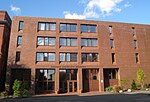Wyss Institute for Biologically Inspired Engineering
The Wyss Institute for Biologically Inspired Engineering (pronounced "veese") is a cross-disciplinary research institute at Harvard University focused on bridging the gap between academia and industry (translational medicine) by drawing inspiration from nature's design principles to solve challenges in health care and the environment. It is focused on the field of biologically inspired engineering to be distinct from bioengineering and biomedical engineering. The institute also has a focus on applications, intellectual property generation, and commercialization. The Wyss Institute is located in Boston’s Longwood Medical Area and has 375 full-time staff. The Wyss is organized around eight focus areas, each of which integrate faculty, postdocs, fellows, and staff scientists. The focus areas are bioinspired therapeutics & diagnostics, diagnostics accelerator, immuno-materials, living cellular devices, molecular robotics, 3D organ engineering, predictive bioanalytics and synthetic biology.
Excerpt from the Wikipedia article Wyss Institute for Biologically Inspired Engineering (License: CC BY-SA 3.0, Authors).Wyss Institute for Biologically Inspired Engineering
Hammond Street, Cambridge
Geographical coordinates (GPS) Address Nearby Places Show on map
Geographical coordinates (GPS)
| Latitude | Longitude |
|---|---|
| N 42.38122 ° | E -71.11626 ° |
Address
Lesley University Doble Campus
Hammond Street
02143 Cambridge
Massachusetts, United States
Open on Google Maps







